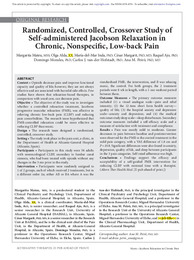Por favor, use este identificador para citar o enlazar este ítem:
https://hdl.handle.net/11000/32358Registro completo de metadatos
| Campo DC | Valor | Lengua/Idioma |
|---|---|---|
| dc.contributor.author | Mateu, Margarita | - |
| dc.contributor.author | ALDA, OLGA | - |
| dc.contributor.author | Inda, María del Mar | - |
| dc.contributor.author | Margarit, César | - |
| dc.contributor.author | Ajo Ferrer, Raquel | - |
| dc.contributor.author | Morales, Domingo | - |
| dc.contributor.author | Van-der Hofstadt, Carlos | - |
| dc.contributor.author | Peiró, Ana | - |
| dc.contributor.other | Departamentos de la UMH::Farmacología, Pediatría y Química Orgánica | es_ES |
| dc.date.accessioned | 2024-06-27T11:17:43Z | - |
| dc.date.available | 2024-06-27T11:17:43Z | - |
| dc.date.created | 2018-11 | - |
| dc.identifier.citation | Alternative Therapies in Health and Medicine. 2018 Nov;24(6):22-30 | es_ES |
| dc.identifier.issn | 1078-6791 | - |
| dc.identifier.uri | https://hdl.handle.net/11000/32358 | - |
| dc.description.abstract | Context: Opioids decrease pain and improve functional capacity and quality of life; however, they are not always effective and are associated with harmful side effects. Few studies have shown that relaxation-based therapies, in comparison with usual care, can decrease pain. Objective: The objective of the study was to investigate whether a controlled relaxation treatment, Jacobson progressive muscular relaxation (PMR), was effective in relieving chronic low-back pain (CLBP) and reducing pain comorbidities. The research team hypothesized that PMR-controlled relaxation could be more effective in reducing CLBP than music. Design: The research team designed a randomized, controlled, crossover study. Setting: The study took place in the pain unit, a clinic, in the Department of Health at Alicante-General Hospital (Alicante, Spain). Participants: Participants in this study were 58 adults with nononcological CLBP, secondary to lumbar canal stenosis, who had been treated with opioids without any changes in the 3 mo prior to the study. Intervention: Participants were randomly assigned to 1 of 2 groups, each of which received 2 treatments, but in a different order (ie, either AB or BA where A was the standardized PMR, the intervention, and B was relaxing music, the control. For both groups, the 2 treatment periods were 8 wk in length, with a 1-mo washout period between them. Outcome measures: The primary outcome measures included (1) a visual analogue scale-pain and relief intensity; (2) the 12-item short form health survey-quality of life; (3) the hospital anxiety and depression scale-anxiety and depression; and (4) the medical outcomes study sleep scale-sleep disturbances. Secondary outcome measures included a self-efficacy scale and a measure of satisfaction with treatment and compliance. Results: Pain was mostly mild to moderate. Greater decreases in pain between baseline and postintervention were observed for the PMR vs the control treatment in the mild pain category, with a VAS difference of 1.8 cm and P = .018. Significant differences were also found in anxiety, depression, quality of life, and sleep between participants in the 3 pain categories. Self-rated adherence was high. Conclusions: Findings support the efficacy and acceptability of a self-guided PMR intervention for reducing CLBP with minimal time with a therapist. | es_ES |
| dc.format | application/pdf | es_ES |
| dc.format.extent | 9 | es_ES |
| dc.language.iso | eng | es_ES |
| dc.publisher | Aliso Viejo, CA : InnoVision Communications | es_ES |
| dc.rights | info:eu-repo/semantics/openAccess | es_ES |
| dc.rights.uri | http://creativecommons.org/licenses/by-nc-nd/4.0/ | * |
| dc.subject.other | CDU::6 - Ciencias aplicadas::61 - Medicina::615 - Farmacología. Terapéutica. Toxicología. Radiología | es_ES |
| dc.title | Randomized, Controlled, Crossover Study of Self-administered Jacobson Relaxation in Chronic, Nonspecific, Low-back Pain | es_ES |
| dc.type | info:eu-repo/semantics/article | es_ES |

Ver/Abrir:
Randomized, Controlled, Crossover Study of.pdf
561 kB
Adobe PDF
Compartir:
 La licencia se describe como: Atribución-NonComercial-NoDerivada 4.0 Internacional.
La licencia se describe como: Atribución-NonComercial-NoDerivada 4.0 Internacional.
.png)